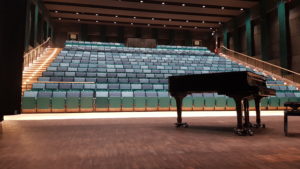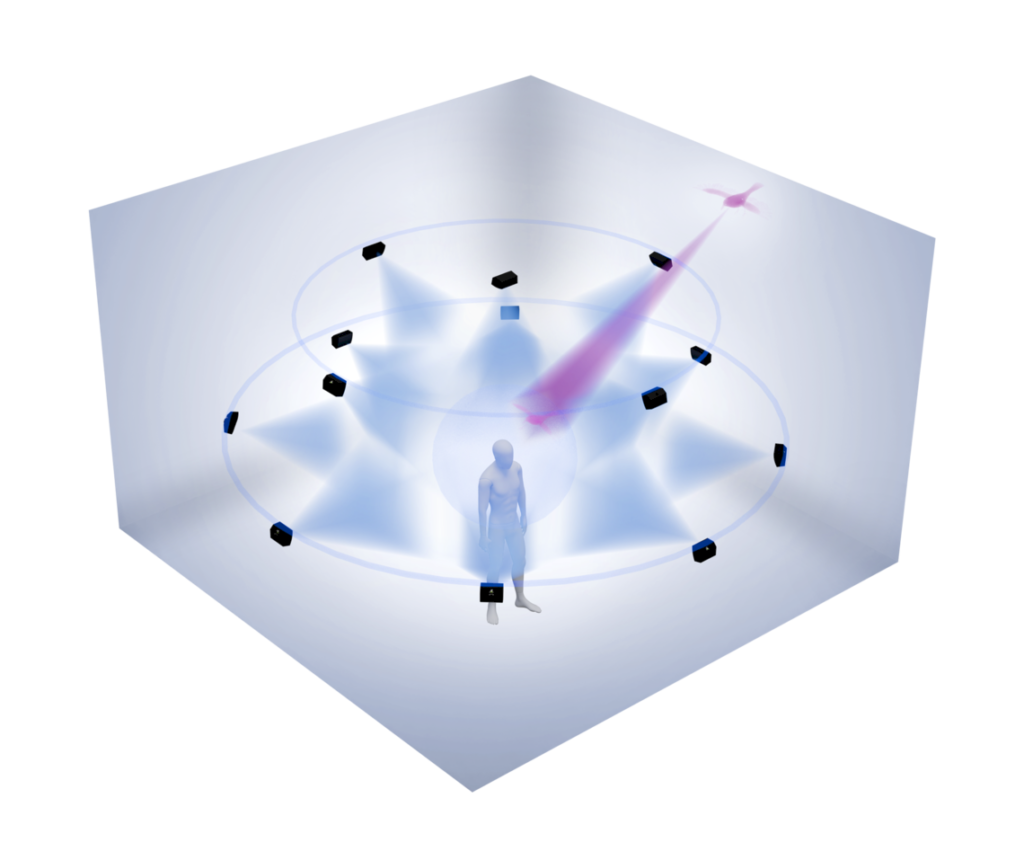NCAC- advertisement: Information about our acoustic and object based audio systems
Acoustic Control Systems (ACS) supplies systems for the enhancement of acoustics. Many systems are operational worldwide in venues as the National Arts Centre in Ottawa and the Royal Opera House Linbury Theatre in London. The world’s finest artists are using ACS on a daily basis, unaware of its presence, just experiencing excellent acoustics.
ACS makes acoustics variable and simply selectable. Sound is recorded at high resolution using multiple microphones; these signals are processed and reproduced over loudspeakers at strategic places in a room. Next to theaters and concert halls ACS can be found on cruise ships, in schools of music, auditoria, and churches.
Pan Immerse 4D Audio is a tool for creating virtual soundscapes. It allows you to freely place and move audio objects in 3-dimentional space. This happens with great precision and without any disturbing artefacts.
Both systems can complement and enhance each other. Audio objects can be placed or moved using Pan Immerse 4D Audio in the acoustics generated by ACS, live sources (musicians) can play simultaneously in this same acoustics. All in all a powerful, highly flexible set of creative tools to provide the finest experience of audio in time and space.
(check the article below!)
ACS is a Pan Acoustics Company
ACS references / ACS product information / Pan Immerse 4D Audio product information / Contact
The Overall Acoustic Experience,
background information on our solutions
Variable Acoustics and Object-Based Audio Supporting Creativity for the Performing Arts
A live performance enhances the connection between audience and performers and provides an irreplaceable emotional and sensory experience. (M Dobson, 2008)
Clearly such an experience is considerably less satisfactory when circumstances are not right.
When a symphony orchestra plays in the dry acoustics of a pop music hall the experience will be downright disappointing for both musicians and audience.
Pop, speech, chamber music, opera, symphonic music, choir, …, all need their specific acoustics to really come to its own.
While a hall may be perfect for speech, you may want to use it for opera and choir, or perhaps a hall is just not good enough for the performances you are programming. Typical cases where ACS electronic acoustic enhancement can dramatically improve the overall experience.
Variable Acoustics
ACS technology is based on science and comes from a close cooperation with the Delft University of Technology in the Netherlands. Continuous development has ensured an increasingly broad and precise implementation of this science.
Electronic Architecture
The generated sound is tailored to the natural acoustics, resulting in fitting, truly natural sounding acoustics. ACS creates multi-functional spaces where good speech intelligibility or church acoustics are simply selectable. This is done by adding a composition of early sound reflections [1] and reverberation.
Early reflections improve the clarity and transmission of sound and therefore enhance the connection between audience and performers. Reverberation carries the music allowing musicians to play and sing with less effort and more detail.
ACS operates as electronic architecture. Its components (microphones, loudspeakers) can be integrated almost invisibly. The whole set-up and quality of the system components is meant to last. (ACS provides 10 years warranty. Some operational systems are running more than 30 years.)
Mechanical Acoustics
Acoustics can be changed using mechanical devices such as panels with an absorbent and a reflective side or by varying the volume of the room. The acoustical range of ACS however will be significantly larger and this at lower costs. No extra building volume for longer reverberation times is required nor any labor and maintenance intensive mechanical devices. Also ACS not: too much hassle to deal with in the limited time between productions.
Orchestra Shell
ACS devotes special attention to the musicians, crucial because the experience becomes much better when musicians are able to play well and are enjoying doing that.
The orchestra shell module supports just that. It uses, loudspeakers positioned above and around the stage. These loudspeakers sometimes hang on fly-bars, and then they are the only mobile part of an ACS installation. However instead of the labor-intensive job of placing a mechanical chamber, hanging the shell ACS can be done swiftly by a single person.
The functionality of the ACS orchestra shell is the same as its mechanical counterpart: helping musicians to better hear each other, improving ensemble playing conditions.
Object-Based Audio
ACS uses a larger number loudspeakers that are distributed throughout the room.
Similar configurations are used by spatial audio systems. Applied in cinemas for several decades, nowadays you’ll also find them in theatres, museums, adventure worlds and live sound applications.
A very advanced system for spatial audio or, better said immersive audio is Pan Immerse 4D Audio.
It enables 128 individual audio objects to be controlled at the same time, each with its specific properties as waveform, room and tonal quality. This can be done using pre-produced content and/or be driven real time, using cues, by manual control or by live tracking systems.
Creativity for the Performing Arts
Like ACS, Pan Immerse 4D Audio is based on Wave Field Synthesis (WFS), a technology allowing separate sound waves to be reproduced through multiple loudspeakers. The basic procedure for WFS was developed at the Delft University of Technology and was further developed over the years, also at the German Fraunhofer Institute which is again at the basis of Pan Immerse 4D Audio.
Already in the 16th century compositions were written describing where instruments or vocals should be located and moved within a room. Pan Immerse 4D Audio can, render objects representing these sound sources and opens up an abundance of possibilities for sound designers and artists to create immersive soundscapes.
No compromises
Pan Immerse 4D Audio makes use of a highly customized Digital Audio Workstation (DAW) and operating system to assure its real live, multi-channel performance. A range of audio and control interfacing as MADI, Dante/AES67 and OSC is available; furthermore can it be combined with tracking systems and show controllers. (as QLab)
Content produced in one room can simply be played in another and it can be used for almost any standard spatial audio format.
The combination of ACS and Pan Immerse 4D Audio, as a unique solution, therefore forms a perfect basis to provide the irreplaceable emotional and sensory experience that anybody is looking for in a live performance.
[1] Sound reflections from walls and ceilings etc. that reach the ear within 100ms after the direct sound, (re-)reflected reflections reach the ear after that are referred to as reverberation.



